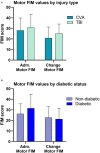Predictors of Functional Outcome in a Cohort of Hispanic Patients Using Exoskeleton Rehabilitation for Cerebrovascular Accidents and Traumatic Brain Injury
- PMID: 34177511
- PMCID: PMC8222710
- DOI: 10.3389/fnbot.2021.682156
Predictors of Functional Outcome in a Cohort of Hispanic Patients Using Exoskeleton Rehabilitation for Cerebrovascular Accidents and Traumatic Brain Injury
Abstract
Traumatic brain injury (TBI) and cerebrovascular accidents (CVA) are two of the leading causes of disability in the United States. Robotic exoskeletons (RE) have been approved for rehabilitation by the Federal Drug Administration (FDA) for use after a CVA, and recently received approval for use in patients with TBI. The aim of the study was to determine which factors predict the improvement in functional independence measure (FIM) score after using RE rehabilitation in a population of patients with CVA or TBI. We carried out a retrospective chart-review analysis of the use of the RE (Ekso® GT) in the rehabilitation of patients with TBI and CVA using data from a single, private rehabilitation hospital for patients admitted and discharged between 01/01/2017 and 04/30/2020. From the medical records, we collected presentation date, Glasgow Coma Scale score (GCS) on the date of injury, rehabilitation start date, age, diabetes status on presentation (Yes or No), injury category (TBI or CVA), and both admission and discharge FIM scores. Matching algorithms resulted in one TBI patient matched to three CVA patients resulting in a sample size of 36. The diabetic and non-diabetic populations showed significant differences between age and days from injury to the start of rehabilitation. A multivariate linear regression assessed predictors for discharge motor FIM and found admission motor FIM score and total RE steps to be statistically significant predictors. For each point scored higher on the admission motor FIM the discharge FIM was increased by 1.19 FIM points, and for each 1,000 steps taken in the RE, the discharge motor FIM increased by three points. The type of acquired brain injury (CVA or TBI) was not found to affect functional outcome. The presented results show that key clinic-biologic factors including diabetic status, together with start to rehabilitation play key roles in discharge FIM scores for patients using RE. Clinical Trial Registration: ClinicalTrials.gov, NCT04465019.
Keywords: diabetes; gait; injury; minorities; trauma.
Copyright © 2021 Treviño, Roberge, Auer, Morales and Torres-Reveron.
Conflict of interest statement
The authors declare that the research was conducted in the absence of any commercial or financial relationships that could be construed as a potential conflict of interest.
Figures


References
-
- Blackwell D. L., Villarroel M. A. (2018). Summary health statistics for U.S. adults: national health interview survey. Natl. Cent. Heal. Stat.
-
- Bruni M. F., Melegari C., De Cola M. C., Bramanti A., Bramanti P., Calabr,ò R. S. (2018). What does best evidence tell us about robotic gait rehabilitation in stroke patients: a systematic review and meta-analysis. J. Clin. Neurosci. Off. J. Neurosurg. Soc. Australas. 48, 11–17. 10.1016/j.jocn.2017.10.048 - DOI - PubMed
Associated data
LinkOut - more resources
Full Text Sources
Medical
Miscellaneous

